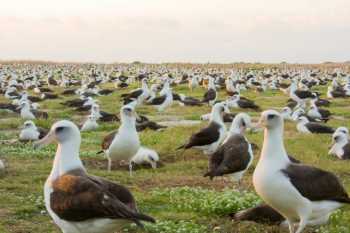Studies have shown that Laysan Albatross Phoebastria immutabilis chicks on USA's Midway Atoll National Wildlife Refuge in the North Pacific exhibit symptoms of lead poisoning most likely related to ingestion of lead-based paint chips and contaminated soil. The primary sources of the paint chips that contaminate the soil where the albatrosses nest are buildings and other structures on the atoll, some of which date back to the early 1900s (see http://www.fws.gov/midway/lpa.html).
The first phase of a US$21 million effort to remove lead-based paint from the atoll is set to commence this year. The clean-up will consist of abatement of lead-based paint from the exterior of 95 buildings (26 of which have already been done), consultation regarding the demolition of certain structures, excavation of soils around the buildings that contain high levels of lead contamination, and disposal of contaminated soil into an on-site containment unit. The excavated areas will be back-filled with clean material and the site will be restored. A work crew of 10-15 people is anticipated. Removal activities will primarily be implemented between July and October when few birds are present on Midway (click here).
The entire project is expected to take five to six years, with reviews of the effectiveness of the project scheduled for every five years thereafter for an undetermined period of time. The clean-up plan prioritizes sites with the highest potential to affect wildlife to be addressed first.
Deaths from lead poisoning in the 2010/11 breeding season were compounded by two severe winter storms and the March tsunami (click here), which killed more than 110 000 Laysan and Black-footed P. nigripes Albatross chicks: about 22% of the season's production. At least 2000 adult albatrosses were also killed.
Click here for an earlier ACAP news story on lead poisoning of albatrosses at Midway.
The area encompassing Midway and its waters was included in the designation of the Papahānaumokuākea Marine National Monument in 2006.

John Cooper, ACAP Information Officer, 18 August 2011

 English
English  Français
Français  Español
Español